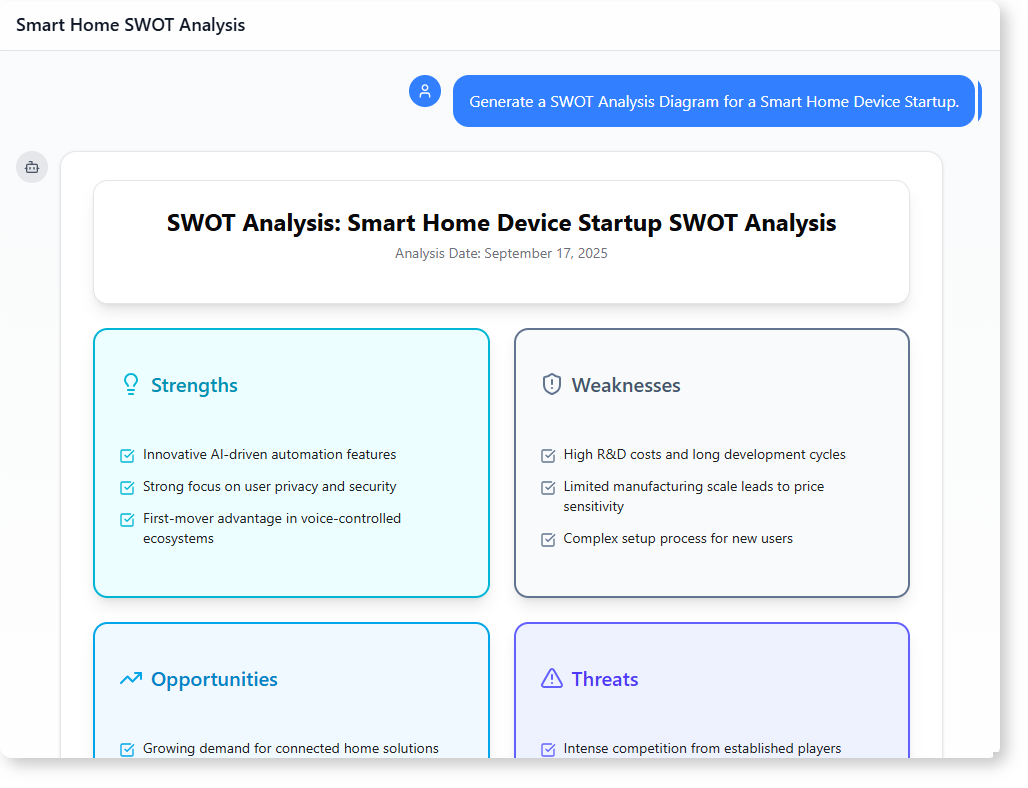Now Reading: How to Generate a Smart Home Device SWOT Analysis with AI-Powered Modeling Software
-
01
How to Generate a Smart Home Device SWOT Analysis with AI-Powered Modeling Software
How to Generate a Smart Home Device SWOT Analysis with AI-Powered Modeling Software
Why a Smart Home Startup Needs a Clear SWOT Analysis
Starting a smart home device company comes with big questions: What are our strengths? Where are the risks? How can we grow?
One of the most practical ways to answer these is through a SWOT analysis. But doing it manually can take hours—especially when you’re balancing a fast-moving market and limited team resources.
That’s where AI-powered modeling software comes in. It doesn’t just generate a SWOT diagram. It helps you see the hidden patterns in your business strategy, turning raw data into clear, actionable insights.

A Real-World Example: From Idea to Insight
Meet Maya, a founder of a new smart home startup. She’s developed a voice-controlled device that learns user habits and automates home routines. But she’s not sure if the idea is viable.
She needs to understand her business environment—its strengths, weaknesses, opportunities, and threats. Instead of spending days researching or building spreadsheets, she decides to use AI-powered modeling software to generate a SWOT analysis.
Step 1: Define the Context
Maya starts by asking the AI:
“Generate a SWOT Analysis Diagram for a Smart Home Device Startup.”
The system responds with a structured SWOT analysis, clearly separating the four categories: Strengths, Weaknesses, Opportunities, and Threats.
This isn’t just a list. It’s a model built to reflect real-world business dynamics. The AI identifies key factors like privacy focus, first-mover advantage, and high R&D costs—details Maya hadn’t fully considered.
Step 2: Understand the Insights
The output isn’t just facts. It’s a strategic foundation.
- Strengths include innovative AI automation, strong privacy focus, and early leadership in voice ecosystems.
- Weaknesses highlight high development costs, limited manufacturing scale, and a complex setup process.
- Opportunities point to rising demand for connected homes, potential platform partnerships, and expansion into energy monitoring.
- Threats include fierce competition, fast-changing tech standards, and consumer doubts about smart device reliability.
Step 3: Turn the Diagram into Actionable Advice
Maya then asks:
“Write a full report that translates the diagram into actionable insights with supporting explanations.”
The AI generates a detailed report. It doesn’t stop at listing points. It explains why each factor matters and how to respond.
For example, it suggests:
- Simplify the onboarding process to reduce user friction.
- Partner with existing smart home platforms to reduce competition risk.
- Launch a pilot program for energy monitoring to test market interest.
This isn’t just a SWOT diagram. It’s a strategy map.
Why This Matters for Startups
Many founders think SWOT analysis is a basic list. But when used with AI-powered modeling software, it becomes a dynamic tool.
It helps identify blind spots—like consumer skepticism or long development cycles—that would be hard to spot without structured thinking.
The AI doesn’t just generate content. It builds context. It turns questions into insights with real-world relevance.
This is especially useful for early-stage startups where time is limited and every decision counts.
How It Works in Practice
The AI modeling tool understands the structure of a SWOT analysis and applies business logic to generate realistic, balanced, and strategic content. It doesn’t guess. It reasons through the core challenges of a smart home device startup.
It doesn’t require any technical skills. You don’t need to know PlantUML, coding, or modeling frameworks. You just describe your business, and the AI builds a clear, readable, and insightful SWOT analysis.
What You Get Back
With this approach:
- You get a clear SWOT diagram in a structured format.
- You receive a full report with explanations and recommendations.
- You gain confidence in your decision-making process.
This is not a one-off. It’s a repeatable process. You can use it for new product ideas, market entry strategies, or every stage of your startup journey.
Is This Right for Your Startup?
If your business involves innovation, product development, or strategy planning—especially in tech-driven fields like smart homes, wearables, or connected devices—this method saves time and adds clarity.
It’s not about replacing human judgment. It’s about empowering founders with faster, deeper, and more accurate insights.
Ready to map out your system’s interactions? Give our AI-powered modeling software a try at Visual Paradigm’s AI Chatbot today!
FAQ
Q1: Can AI really produce a meaningful SWOT analysis for a startup?
A: Yes. When prompted correctly, AI-powered modeling software generates a balanced, realistic SWOT analysis based on industry patterns and startup dynamics. It doesn’t just list points—it explains their relevance.
Q2: Is this tool suitable for non-technical founders?
A: Absolutely. The process requires no technical knowledge. You describe your product or idea, and the AI builds the analysis using clear, business-focused language.
Q3: Does this tool support SWOT for different types of startups?
A: The AI is adaptable. Whether you’re building a smart home device, a health app, or a sustainability solution, it can generate relevant SWOT content based on the context provided.
Q4: How does this differ from a traditional SWOT tool?
A: Traditional tools are static. This AI-powered modeling software adds depth through real-world context and actionable insights. It doesn’t just list strengths—it helps you understand how to act on them.
